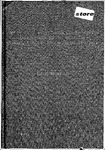THE EFFECT OF HEAVY METAL CONTAMINATION ON ESTUARINE BENTHIC FAUNA AT VARYING LEVELS OF BIOLOGICAL ORGANISATION
| dc.contributor.author | PERRYMAN, SARAH ALICIA MICHELLE | |
| dc.contributor.other | School of Biological and Marine Sciences | en_US |
| dc.date.accessioned | 2012-08-02T10:59:22Z | |
| dc.date.available | 2012-08-02T10:59:22Z | |
| dc.date.issued | 1996 | |
| dc.identifier | Not available | en_US |
| dc.identifier.uri | http://hdl.handle.net/10026.1/1083 | |
| dc.description.abstract |
Biological monitoring techniques, selected to cover increasing levels of biological organisation (cellular, individual, population and community), were compared and contrasted to determine the relative sensitivities of these approaches to heavy metal contammation. The study was centred on the Fal Estuary in Cornwall, an ideal experimental field site-with well documented heavy metal contamination resulting firom the long-term discharge of waste from a local tin mine. Five creeks leadmg from the estuary differ dramatically in the concentrations of heavy metals in the sediments, but little in natural environmental variables (sediment granulometry, salinity etc.). The contaminant induced damage was evaluated at the cellular level in Mytilus edulis by the Neutral Red Assay to detect lysosomal membrane damage. Parameters of the energy budget of this species were determined to estmiate 'Scope for Growth' of mdividuals. along with a Larval Survival assay to estabUsh their reproductive and developmental success. At the population level. Cohort Growth studies were undertaken using the polychaete Nephtys hombergi. At the community level, data firom an extensive three year survey of benthic macrofauna structure were analysed. In addition to investigating biological parameters, contammant levels in sedunent and tissue were determuied using Atomic Absorption Spectrommetry. All techniques, except the population level, detected the extreme pollution of the most contaminated creek, Restronguet, but did not accurately reflect the known metal gradient. However, community studies established distinct macrofaunal assemblages between both sites and years. Techniques were compared and validated in a novel approach using the program BIOENV, with the multivariate analysis package PRIMER (Plymouth Routines in Multivariate Ecological Research). The cellular assay correlated reasonably well agamst the heavy metal levels, the larval survival assay correlated well to the community structure. However, the community structure approach was the most sensitive and relevant monitoring method to determme the long-term contamination of the Fal Estuary. | en_US |
| dc.description.sponsorship | Plymouth Marine Laboratory | en_US |
| dc.language.iso | en | en_US |
| dc.publisher | University of Plymouth | en_US |
| dc.title | THE EFFECT OF HEAVY METAL CONTAMINATION ON ESTUARINE BENTHIC FAUNA AT VARYING LEVELS OF BIOLOGICAL ORGANISATION | en_US |
| dc.type | Thesis | en_US |
| dc.identifier.doi | http://dx.doi.org/10.24382/1404 | |
| dc.identifier.doi | http://dx.doi.org/10.24382/1404 |
Files in this item
This item appears in the following Collection(s)
-
01 Research Theses Main Collection
Research Theses Main


